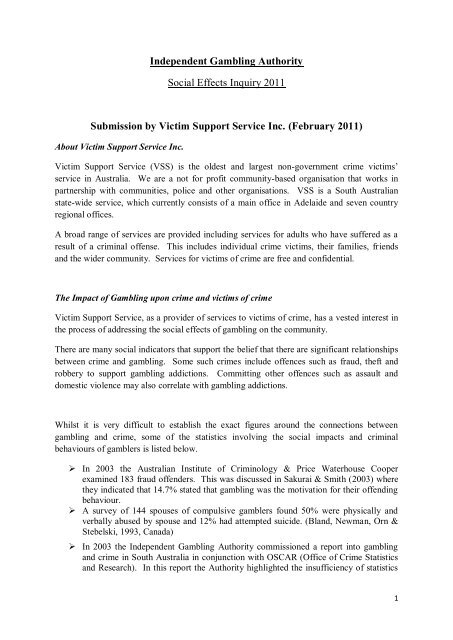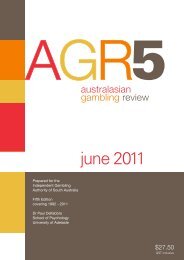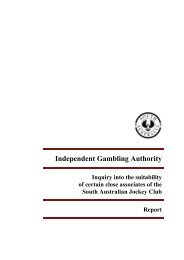Victim Support Service - Independent Gambling Authority
Victim Support Service - Independent Gambling Authority
Victim Support Service - Independent Gambling Authority
- No tags were found...
You also want an ePaper? Increase the reach of your titles
YUMPU automatically turns print PDFs into web optimized ePapers that Google loves.
<strong>Independent</strong> <strong>Gambling</strong> <strong>Authority</strong>Social Effects Inquiry 2011Submission by <strong>Victim</strong> <strong>Support</strong> <strong>Service</strong> Inc. (February 2011)About <strong>Victim</strong> <strong>Support</strong> <strong>Service</strong> Inc.<strong>Victim</strong> <strong>Support</strong> <strong>Service</strong> (VSS) is the oldest and largest non-government crime victims’service in Australia. We are a not for profit community-based organisation that works inpartnership with communities, police and other organisations. VSS is a South Australianstate-wide service, which currently consists of a main office in Adelaide and seven countryregional offices.A broad range of services are provided including services for adults who have suffered as aresult of a criminal offense. This includes individual crime victims, their families, friendsand the wider community. <strong>Service</strong>s for victims of crime are free and confidential.The Impact of <strong>Gambling</strong> upon crime and victims of crime<strong>Victim</strong> <strong>Support</strong> <strong>Service</strong>, as a provider of services to victims of crime, has a vested interest inthe process of addressing the social effects of gambling on the community.There are many social indicators that support the belief that there are significant relationshipsbetween crime and gambling. Some such crimes include offences such as fraud, theft androbbery to support gambling addictions. Committing other offences such as assault anddomestic violence may also correlate with gambling addictions.Whilst it is very difficult to establish the exact figures around the connections betweengambling and crime, some of the statistics involving the social impacts and criminalbehaviours of gamblers is listed below.‣ In 2003 the Australian Institute of Criminology & Price Waterhouse Cooperexamined 183 fraud offenders. This was discussed in Sakurai & Smith (2003) wherethey indicated that 14.7% stated that gambling was the motivation for their offendingbehaviour.‣ A survey of 144 spouses of compulsive gamblers found 50% were physically andverbally abused by spouse and 12% had attempted suicide. (Bland, Newman, Orn &Stebelski, 1993, Canada)‣ In 2003 the <strong>Independent</strong> <strong>Gambling</strong> <strong>Authority</strong> commissioned a report into gamblingand crime in South Australia in conjunction with OSCAR (Office of Crime Statisticsand Research). In this report the <strong>Authority</strong> highlighted the insufficiency of statistics1
kept showing the full impact of gambling upon crime. The reasons given for this lackof statistics includeo A number of offences will never be detected,o Even if detected, offences may not be reported to police,o Not all problem gamblers attend treatment services, ando Not all gamblers who access services will disclose criminal activities.However, this report highlighted the percentage of prisoners in Australian prisonswho were assessed as problem gamblers. It varied from state to state, however thehighest was in South Australia where 33% were assessed to be in this category.(Marshall & Marshall, 2003)Whilst the main studies into the relationship between gambling and crime to date haveinvolved the study of offenders, <strong>Victim</strong> <strong>Support</strong> <strong>Service</strong> and other providers of services tovictims are required to address gambling from a different perspective. It is evident thatgambling does inherently impact on crime, and providers of support services should beinvolved in addressing the social impact on those victims.In many ways the families and friends of problem gamblers are in their own ways victims,not necessarily of crime, but of the impact left behind by gambling. In a report into therelationship between crime and pokie machines, conducted by the Department of Justice inVictoria, they reported that up to 70% of problem gamblers may commit crimes. (Statisticstaken from “Pokie tie to Crime”, Sydney Herald Sun, Sunday November 28,2010).However the impacts do not solely occur to families and friends of problem gamblers.Recently there has also been an increased number of crimes against Pokie/Hotel venues byarmed offenders, and increased attacks such as aggravated robberies against the gamblersthemselves.So, in many ways gambling, gamblers and licensed venues are intricately involved in crimeson many different levels, as targets, as criminals and as innocent bystanders.In addition it is our experience that for some people who have been a victim of crime andsubsequently experience post-traumatic stress reactions that they may rely on different formsof gambling as a coping strategy. For example, many clients report a reliance on ‘pokies’ asa strategy for coping with what has happened to them, however this then often leads toadditional financial pressure and emotional stress being placed on the individual and/orfamily of the victim.2
Recommendations<strong>Victim</strong> <strong>Support</strong> <strong>Service</strong> believes that a collaborative interagency approach is required todecrease the impact upon victims involved in the cycle that is problem gambling. This willinvolve a partnership between many agencies to provide a combined crime preventionstrategy. We propose that this includes, but is not limited to:‣ Early intervention and programmes to develop restorative approaches andvictim awareness‣ Anti–gambling education and awareness campaigns‣ Education, self esteem and skills of ‘at risk’ groups and during life transitionpoints‣ Parental education & intervention in ‘at risk’ groups, and‣ Improved, targeted & effective offender rehabilitation.Some of the recommendations or considerations that need to be addressed to decrease theprobability and impact of crime include –a. Increased security for venues after dark including,i. secure access to vehicles,ii. well lit parking areas for all venues,iii. increased taxi access points,iv. requirement for security CCTV in all venues, andv. security personnel at all venues with gambling facilities.b. Increased awareness programs for gamblers and greater access to supportservices, including support services advertised on every machine and in everyvenue,c. Increased awareness for venue staff addressing,i. limits to cash amounts given to gamblers after gambling, andii. ability to detect suspicious behaviour of others in venues.d. Increased advertising showing support services for non-gamblers affected bygambling,i. Increased advertising to highlight behaviours related to problem gambling,ii. Increased access to, and advertising of, services available in local areas (inparticular country South Australia).e. Increased funds / grants available to support services working with,i. Offenders who highlight gambling as reason for offending,ii. victims of crime with problem gambling habits, andiii. families and friends of gamblers.f. <strong>Support</strong> services in prisons available to offenders to address gambling duringincarceration.g. Restorative justice approaches to offenders who commit crime to supportproblem gambling.3
ReferencesBland, R. C., Newman, S. C., Orn, H., & Stebelsky, G. (1993). Epidemiology of pathologicalgambling inEdmonton. Canadian Journal of Psychiatry, 38, 108-112.Marshall, Jayne, Marshall, Amy, <strong>Gambling</strong> and Crime in South Australia, Attorney General’sDepartment, Office of Crime Statistics and Research, December 2003Pinto, S., & Wilson, P., <strong>Gambling</strong> in Australia; Trends & Issues in Crime & CriminalJustice; Australian Institute of Criminology; No. 24; July 1990; found at -http://www.aic.gov.au/documents/A/A/2/%7BAA236B7C-0159-4A84-8F90-C74158D97540%7Dti24.pdfSakurai, Y., Smith, R. G., <strong>Gambling</strong> as a motivation for the commission of financial crime,Trends & Issues in Crime & Criminal Justice; Australian Institute of Criminology; June2003, 241-260http://www.aic.gov.au/publications/current%20series/tandi/241-260/tandi256/view%20paper.aspx4





